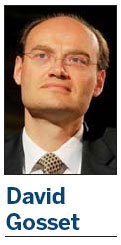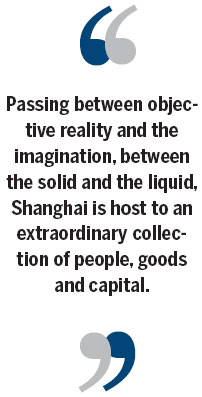City above the sea flows on
Updated: 2013-06-21 08:58
By David Gosset (China Daily)
|
|||||||||||

Ever-growing, ever-moving, ever-changing, you cannot pin down Shanghai to one iamge
On a world map the coordinates of Shanghai are unequivocal, but as a human representation the mega-city lies between the rational and precise studies of the experts, geographers, economists and sociologists, and the infinite power of evocation of its name.
Cinematic more than photographic, Shanghai is difficult to capture, like the streams that crisscross its flat land - the great Yangtze, the Huangpu River, the Suzhou Creek and their tributaries.
The Bund, a waterfront that displays an eclectic architecture, is often presented as the symbol of the Chinese metropolis. But it is only one of its most picturesque faces. One penetrates Shanghai's soul better via fluvial navigation, wandering somewhere between the land and the sea.
As suggested by its two Chinese characters which mean "above the sea", Shanghai has left the shore but not yet entered the Pacific.
In a sense, it can be seen as an intermediate between Beijing and Hong Kong - Beijing, once a Forbidden City, immobile on the continent; Hong Kong, a green vessel ready for sailing; Shanghai, a passage between the firm ground and the amorphous immensity of the ocean.
In an effective rendering of the city's rhythms and colors, This Is Shanghai, a time-lapse video made by Rob Whitworth and J.T. Singh, reveals the pulse that beats from the waterways to the traditional alleys, the nongtang. It visualizes Aldous Huxley's famous comment: "Shanghai Bergson's elan vital in the raw It is Life itself."

Passing between objective reality and the imagination, between the solid and the liquid, Shanghai is host to an extraordinary collection of people, goods and capital.
With 6 million inhabitants at the beginning of the 1950s, 16 million in 2000, 25 million today, 30 million by 2020, it does not take long for the map of a city under construction to become obsolete.
The urban extension is horizontal as much as vertical. The steel pagoda, the Jin Mao Tower (420 meters), and the Shanghai World Financial Center (close to 500 meters) are already familiar landmarks of Lujiazui, Pudong's new financial district. But after its completion in 2014, the 632-meter Shanghai Tower will dominate a forest of more than 4,000 skyscrapers - twice the number of New York City.
The dream of material success, which inspired the merchants of London and the capitalists of New York City, pervades the Yangtze delta, and the vast majority of the city's 173,000 foreign citizens - a quarter of China's expatriates - identify their new home as a Chinese El Dorado.
Last year, with a GDP of $323 billion (242 billion euros) - it was around $130 billion six years ago - Shanghai would have been the 34th largest economy in the world.
While the myth of the Old Shanghai is more a narrative cultivated by a few foreigners than a living point of reference for the Shanghaiers, futurism cannot be the collective project of a city fully immersed in its present.
Neither profoundly nostalgic nor excessively preoccupied by the future, Shanghai has an instinctive passion for the newness and the promise of each day.
Not seriously concerned by the choice between Puxi and Pudong, the West and the East, the old and the new, Shanghai moves like a continuous flow of life, and one can easily imagine how the vigor of its pulse could have changed the fate of Thomas Mann's fictional character Gustav von Aschenbach in Death in Venice, metamorphosed into life in Shanghai.
The author is director of the Academia Sinica Europaea at China Europe International Business School, Shanghai, Beijing & Accra, and founder of the Euro-China Forum. The views do not necessarily reflect those of China Daily.
( China Daily European Weekly 06/21/2013 page11)
Today's Top News
List of approved GM food clarified
ID checks for express deliveries in Guangdong
Govt to expand elderly care
University asks freshmen to sign suicide disclaimer
Tibet gears up for new climbing season
Media asked to promote Sino-Indian ties
Shots fired at Washington Navy Yard
Minimum growth rate set at 7%
Hot Topics
Lunar probe , China growth forecasts, Emission rules get tougher, China seen through 'colored lens', International board,
Editor's Picks

|

|

|

|

|

|





